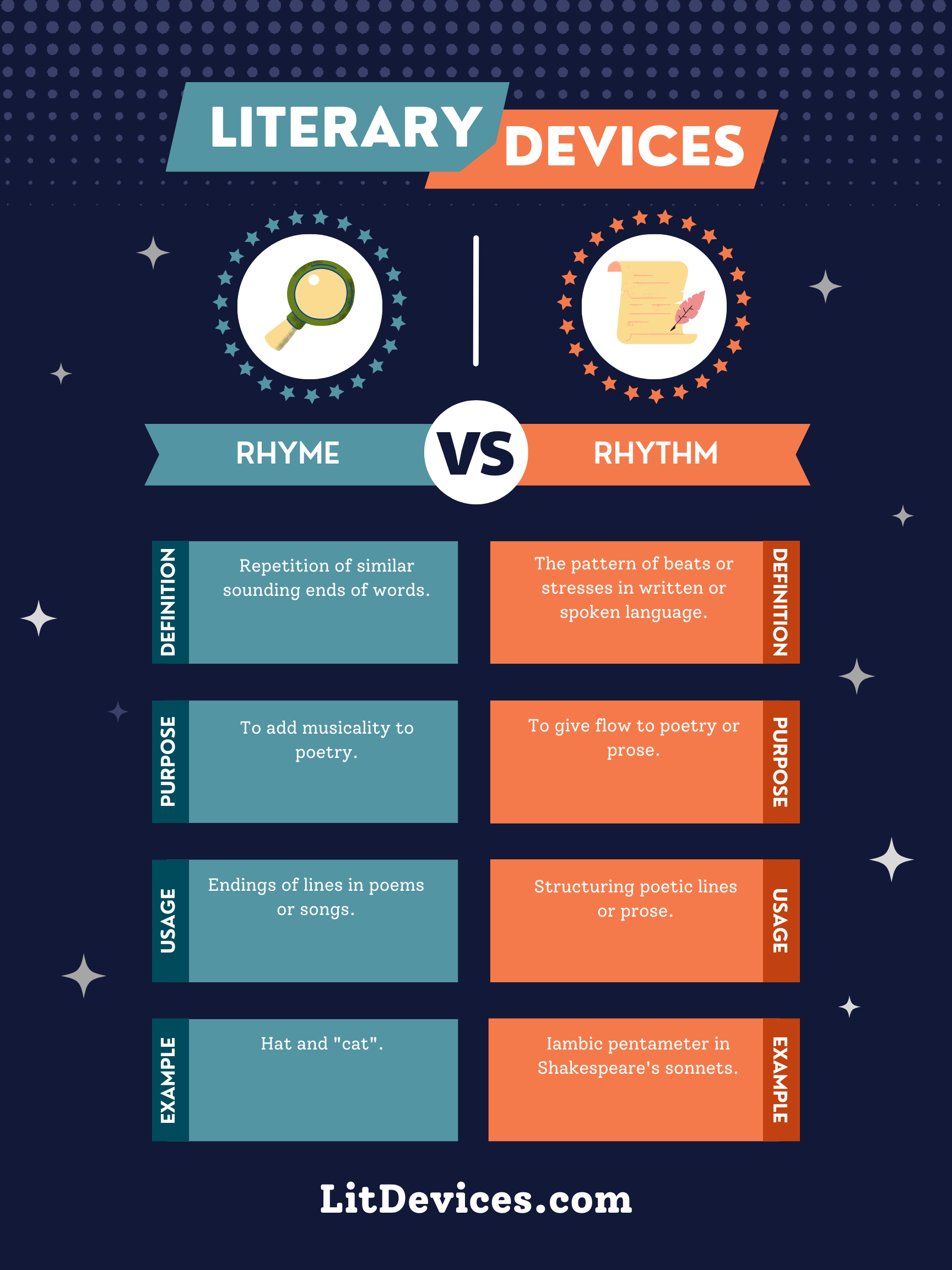Rhyme is the repetition of similar sounding words; Rhythm is the pattern of beats or stresses in language.
These two literary devices are essential in the crafting of engaging and memorable poetry and prose. They add musicality and depth to language, captivating readers and listeners alike. Let’s dive into each of these devices, exploring their unique qualities and contributions to the literary world. 📖🎶
Rhyme
Rhyme is the repetition of similar sounding words occurring at the end of lines in poems or songs. It creates a pleasing auditory effect, enhancing the musicality of the language. For example, Emily Dickinson’s poem “Because I could not stop for Death” employs an ABCB rhyme scheme, where the second and fourth lines rhyme:
Because I could not stop for Death –
He kindly stopped for me –
The Carriage held but just Ourselves –
And Immortality.
Rhythm
Rhythm, on the other hand, is the pattern of beats or stresses in spoken or written language. It gives poetry its flow and tempo. An excellent example of rhythm is found in Edgar Allan Poe’s “The Raven,” which uses trochaic octameter, creating a distinct and memorable beat:
Once upon a midnight dreary, while I pondered, weak and weary,
Summary
| Literary Device | Definition | Purpose | Usage | Relevant Examples |
|---|---|---|---|---|
| Rhyme | Repetition of similar sounding words at the end of lines. | To add musicality and enhance memorability. | Poetry, songs, some prose. | “Because I could not stop for Death” by Emily Dickinson. |
| Rhythm | Pattern of beats or stresses in language. | To provide flow and tempo to the language. | Poetry, prose, speeches. | “The Raven” by Edgar Allan Poe. |
Writing Tips
To incorporate rhyme and rhythm effectively in your writing, consider these tips:
- Experiment with Different Rhyme Schemes: Beyond the common AABB or ABAB schemes, explore slant rhymes or internal rhymes to add variety to your work.
- Play with Meter for Rhythm: Understanding meters like iambic pentameter or trochaic tetrameter can greatly influence the rhythm of your poetry. Read your work aloud to feel the beat.
- Use Rhyme and Rhythm Purposefully: Let these devices serve your content. Rhyme can emphasize important points, while rhythm can affect the mood or pace.
- Practice and Read Aloud: The best way to understand the effect of rhyme and rhythm is to hear it. Read widely and out loud to get a sense of how these devices work together.
FAQs
How do rhyme and rhythm work together?
Rhyme and rhythm often work in tandem to create a musical quality in poetry, with rhyme providing a pattern of sounds and rhythm giving the poem its beat.
Can prose have rhythm without rhyme?
Yes, prose can have a rhythmic quality without employing rhyme. Rhythm in prose is often created through varied sentence lengths and strategic use of punctuation.
Is rhyme necessary for poetry?
No, not all poetry must rhyme. Free verse, for example, relies more on rhythm and other devices than on rhyme.
Exercise
Consider the following lines:
The sun sets in a blaze of orange glory,
Its light fades as the day ends its story,
Night whispers the promise of a new day,
While stars in the sky in patterns sway.
Answers: The lines exhibit an AABB rhyme scheme. The rhythm is maintained by a consistent meter with each line approximately matching in syllable count and stress, creating a smooth flow.
Other Interesting Literary Device Comparisons
- Metaphor vs Simile: Both are comparative devices, but metaphors assert direct comparisons, while similes use “like” or “as.”
- Alliteration vs Assonance: These phonetic devices embellish texts; alliteration repeats consonant sounds, and assonance repeats vowel sounds.
- Imagery vs Symbolism: Imagery uses descriptive language to appeal to the senses, while symbolism conveys deeper meanings through objects, actions, or events.
Exploring these devices further can enhance your understanding and appreciation of literary artistry. 📚✨

